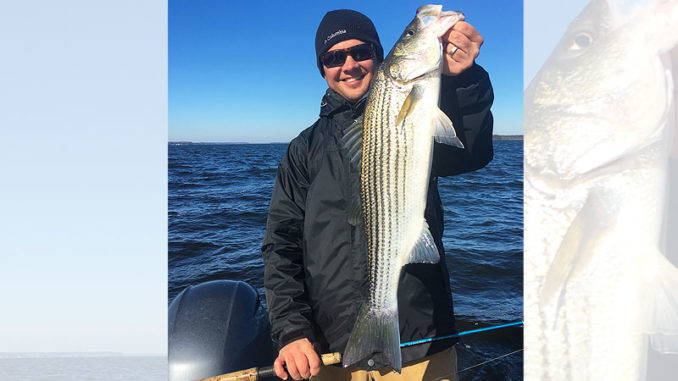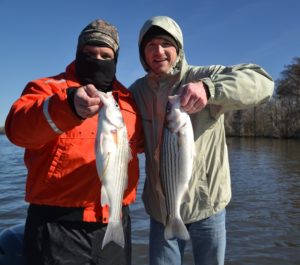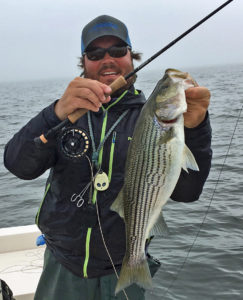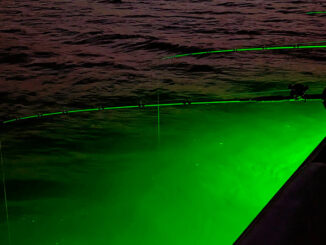
Striped bass, aka rockfish, keep North Carolina’s coastal rivers alive during the colder months.
Striper fishing in North Carolina’s Pamlico River is a lot like an undiscovered jewel. There aren’t any large towns along the river, and fishing there is primarily enjoyed by locals and a few who know about the good fishing and are willing to make it a day trip. The number of boat ramps is increasing, but there aren’t an abundance of places to stay, and this makes it difficult to enjoy the excellent fishing for a week — or even a weekend.
Richard Andrews of Tar-Pam Guide Service knows the river and is an excellent advocate. Headquartered in Bath, N.C., he fishes the Pamlico from above Washington, at its junction with the Tar River and requires an inland fishing license, to the mouth of the Pamlico Sound below Swan Quarter. He catches flounder, speckled trout, red drum and more, but he specializes in striped bass. Andrews fishes striped bass, aka rockfish, year-round, but they really move to the top of the list as the water cools through the fall into the winter.
“Weather seriously affects our fishing,” Andrews said. “The river is wide, but an abundance of rain can make it dirty, and a deluge like the hurricanes this fall can keep it dirty for a while. When the river gets dirty, I concentrate on the creeks and smaller rivers that run into it and can usually find cleaner water and bait — and both are keys to catching rockfish.”
On a trip last winter, Andrews tried to dodge dirty water in the main river and a wind that reached 20 knots by early afternoon. He fished the Pungo River from near its mouth back to Belhaven and ducked into several creeks to escape the wind. He had more luck dodging the wind than finding clean water, but he found several schools of baitfish and led anglers Josh Roberson and Jeff Butler to a handful of stripers.
“There isn’t a lunar tide here, so we rely on the wind to move water, and that moves the bait,” Andrews said. “We’ll try a few close places this morning on our way out and probably check them again later. They’re good spots, and I hate to ride by them when they’re this close but they’ll probably be better once the wind picks up a little and begins moving the water. Hopefully, we’ll catch a few fish early while it’s calm.”

One of the first places Andrews stopped was the NC 92 bridge, where there was deeper water; he had one of his fishermen casting a Rat-L-Trap and the other a Rippin’ Rap, counting them down for a few seconds, then jigging them vertically and letting them settle again. Both baits had the factory treble hooks replaced with single hooks for easy in releasing fish.
One cast produced a quick hookup to a strioper that hit hard, bent the rod deeply and tried to run back around a piling. Some skillful rod handling and a well-set drag stopped it short. A few minutes later, the tired striper was led to the landing net.
Andrews checked several places headed towards open water, but he never found the water clarity or bait he wanted to see. He stopped at the bridge again before heading into the Pungo, with the wind building and current trails tapering off the pilings. This stop produced four strikes and two fish in a half-hour.
A chop was building on the Pungo, so Andrews decided to check the Belhaven breakwater before heading farther out. He eased near the breakwater and set his Lowrance unit for downscan and sidescan, allowing him to look for bait and fish under the boat snd beside it.
He located a school of bait a little off the breakwater, with larger marks around the outside. Once again, a few minutes of casting produced several strikes, but only one got the hook well enough to be landed. Meanwhile, Andrews had been watching a flock of diving and wheeling birds a ways out in the river. He said the birds had to be on bait, but were moving pretty quickly. The fishfinder again showed a few larger marks around the bait, but nothing was hungry.
Andrews’ anglers also fished soft plastics: 3-inch Z-Man Minnowz and 4-inch Swimming Trout TrickZ on 3/16-ounce Trout EyeZ and 1/4-ounce Redfish EyeZ jigheads to see if different sizes and sink rates would produce better.
Andrews’ party caught more fish around stump beds and docks.
Striper regs for coastal rivers
On Oct. 1, 2018, the N.C. Wildlife Resources Commission announced a new size limit for striped bass in inland waters within the Central-Southern Striped Bass Management Area.
For the 2018-2019 striped bass harvest season, which runs from Oct. 1, 2018 to April 30, 2019, the minimum size is 26 inches, with a two-fish daily creel limit.
The waters covered by these regulations include:
- The Tar and Pamlico rivers and tributaries from Rocky Mount Mill Dam downstream to the Norfolk Southern Railroad Bridge at Washington;
- The Neuse River and its tributaries from Falls Lake Dam downstream to Pitchkettle Creek;
- Pungo River upstream of the US 264 bridge at Leechville;
- All other unlisted inland waters of coastal rivers and tributaries except the Cape Fear River and tributaries. There is a moratorium on striped bass in the Cape Fear River system; no possession is allowed at any time.
Fly-fishing for stripers

Guide Richard Andrews said fly-fishing for striped bass in the Pamlico River system is as good as he has seen anywhere. The options include fishing schooling fish in open water, working vertical structure like docks and bridges and working subsurface structure like stumps, old broken pilings, a few small shipwrecks and rubble or oyster beds.
Fishing is usually pretty good and can be excellent at any time of the year, but Andrews considers late fall and winter as the best.
The ultimate action is schooled stripers feeding on herded bait in open water. Concentrations of wheeling, diving birds give away the locations of these schools and make carrying good binoculars a must. This action is usually hot and heavy and often produces 100 fish plus days.
Andrews cautions anglers not to overlooking structure for the spectacle of stripers under birds. The water is rarely clear enough to sight-cast, but it happens occasionally in calm, dry weather. However, there are plenty of points, groins, banks, docks, jetties and bridges that are known to hold rockfish — plus trout, drum and flounder.
Andrews likes to fish a little lighter, using 6-weight rods and line, but equipment from 6- to 8-weight will get the job done.
Andrews carries several Sage rods rigged with Rio sinking-tip fly line and several rigged with Rio streamer tip line that sinks even faster. He fishes a lot of small, white Clousers and said they work great when fish are feeding on bay anchovies. However, sometimes they herd up schools of smaller menhaden, and a larger fly with a fuller profile, is needed.
Andrews also carries one rod rigged with floating line in case stripers are feeding on the surface. He likes to use poppers from Flyman Fishing Company in Brevard, N.C., that have a slight swimming motion.
DESTINATION INFORMATION
HOW TO GET THERE — The Pamlico River can be accessed from US 264 on the east side and NC 33 on the west side. Both cross US 17 near Washington. Bath, off US 264, is another prominent access between Washington and Belhaven on the eastern side of the river. Four public ramps are off US 264 between Washington and Swan Quarter.
WHEN TO GO — Stripers are in the Pamlico River all year, but big schools tend to be more common during the colder months. Red drum and speckled trout may be mixed with stripers and caught while fishing for stripers.
BEST TECHNIQUES — Medium-light to medium action spinning rods and 2500 class reels spooled with 10- to 20-pound brade are common for stripers. Rat-L-Trap, Rippin’ Raps and Z-Man soft plastics fished on 1/4- to 3/16-ounce jigheads are productive.
FISHING INFO/GUIDES — Richard Andrews, Tar-Pam Guide Service, 252-945-9715, East Side Bait & Tackle, Washington, 252-946-2186, www.eastsidebaitandtackle.com; Radcliffe Marine, Belhaven, 252-943-3923, www.radcliffemarine.com. See also Guides & Charters in Classifieds.
ACCOMMODATIONS — Washington- Beaufort County Chamber of Commerce, 252-946-9168, www.wbcchamber.com; Hyde County Chamber of Commerce, 888-493-3826,
www.hydecountychamber.org.
MAPS — Capt. Segull’s Nautical Charts, 888-473-4855, www.captainsegullcharts.com; Sealake Fishing Guides, 800-411-0185, www.thegoodspots.com; GMCO’s Chartbook of North Carolina, 888-420-6277, www.gmcomaps.com.


